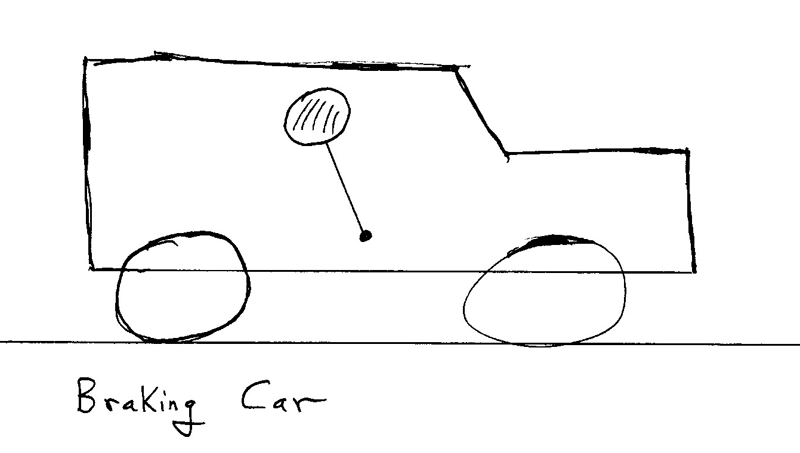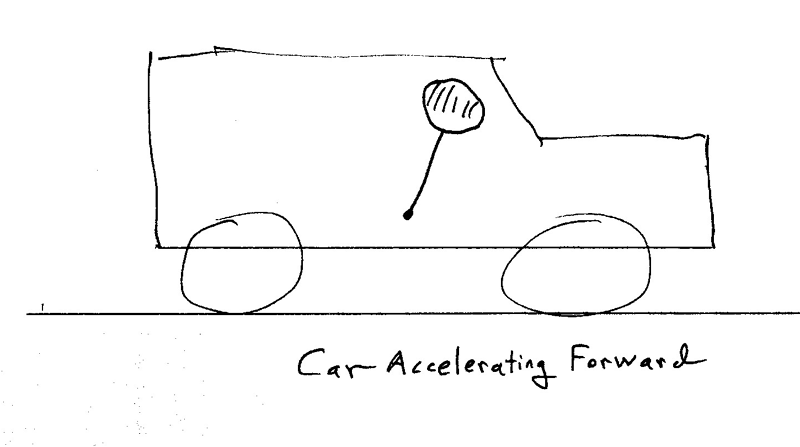
You really should "try this one at home" (actually, in a closed car), because it is always an exciting and strange thing to see. Look for a nice straight section of divided highway, and go out early some morning when no other cars are on the road. Watch out for other cars - You don't want to get so interested in your physics that you have an accident! What you will find when you hit the brakes is this - while everything else in the car (you in your seat belt, a book you left on the seat next to you, the box of blueberries on the rear shelf over the back seat) will "try" to go forward, the helium balloon will happily tilt backward !

The simplest way to understand what's going on is to think first about how the balloon behaves when you're standing still with it or when you're in the car with it but going along a straight road at a steady speed. Whereas everything else "wants" to go down (because of gravity), the balloon wants to go straight up. That's really because helium is lighter than the air around it. (In a perfect vacuum, say on the surface of the moon, the balloon - like everything else - would fall down.) Anyhow, the balloon (in air) acts as if "gravity" were pointing in the wrong direction - wrong in comparison with everything else. (This "upward gravity" for the balloon is also somewhat weaker than the downward gravity that acts on everything else. How much weaker depends on how much lighter than air the helium is, but we aren't going to worry about the size of the effect; instead just concentrate on the fact that it's in the wrong direction.)
Now back to the braking car. For you and the book and that box of blueberries, it's as if there were an extra "gravitational force" forward. So now we shouldn't be surprised to find that for the balloon, it's as if there were an extra "gravitational force" in the backward direction. End of story.
[That seems to us the simplest way of discussing the balloon problem. But it's not the only way. Down below (after the two sketches, we mention an alternative.)]
Well, not quite the end of the story. Unless the "extra gravitational force" is a significant fraction of the normal gravitational force, we won't notice the effect. We do need some numbers. So, the question is, how does our real acceleration compare with "g", the acceleration due to gravity, which is about 9.8 (m/sec)/sec or 9.8 m/sec² = 32 feet/sec² ? Our acceleration doesn't have to be as big as g, or even half as big, but if it were only, say, 0.001 g, we probably wouldn't notice the effect. One day recently, one of us measured how long it took us (without causing an accident) to change our speed from 50 miles/hour to zero.We measured this as 6.6 seconds, giving us an acceleration whose magnitude is (50/6.6) miles/(hour-second). After some necessary conversions of units, this turns out to be about 12.2 feet/sec², which is about 0.38 g. Easily noticeable.
Also, think about this. When you slam on the brakes, all the "normal" stuff tends to fly forward, and the balloon tilts the "wrong" way, i.e., backward. What if you are stepping on the gas, accelerating forward? In that case, all the normal stuff (e.g., you in your seat belt) feels an apparent "gravitational force" backward, pushing you back into your seat. (The times that you feel that apparent backward force most strongly are when you're a passenger in a plane, picking up speed down the runway for takeoff.) If you and all the other normally behaving objects feel a "force" backward, then by this time you won't be surprised to see that the balloon tilts forward as the car picks up speed. How big might this apparent force be, in comparison with normal gravity? Again, we need to know how our forward acceleration compares with g. In a recent such experiment in a Prizm, we accelerated from zero to 50 mph in about 10.5 seconds, giving us an acceleration of (50/10.5) miles/(hour-second). And after again converting the units, this works out to be an acceleration of about 8 feet/sec², which is about 1/4 g. Again, easily noticeable.

What we described above, introducing the "extra gravitational force", is really the simplest way to understand the problem and to predict correctly what will happen in various situations. And it's a completely air-tight argument, even though it leaves some skeptics wondering what happens to the air, the string, etc. You can, if you want, alternatively think about how the air in the car moves (relative to the car) when you slam on the brakes or step on the accelerator, and what the balloon does as a result. (The air in the car, and everything else, tends to "fly forward". But helium, being lighter than air, isn't as strongly affected as the air, so the air tends to pile up toward the front of the car. And so the helium balloon tilts toward the rear.) But that approach is not at all necessary - and seems to us a good deal more complicated. For justification of the "effective force of gravity" argument, listen to Albert Einstein. (This is "Einstein's Theory of General Relativity", but we only need the basics, not the intricate and advanced parts that would allow us to understand black holes and all those wonderful things.) What Einstein pointed out is that what we sense as a gravitational force is indistinguishable from being in an accelerated frame of reference. The classic example is an elevator. If you are in an elevator that is accelerating upward, there is no way that you can tell the difference between that and being in a stationary elevator (or one that is moving at constant velocity) with stronger downward gravity.
Einstein called this the "Equivalence Principle": Being in an accelerated frame of reference is equivalent to having an additional force of gravity.
Unless you "cheat" by looking out the window, there is no way of telling the difference between upward acceleration, on the one hand, and extra downward gravity. The same thing holds inside the car. Slam on the brakes and your acceleration is in the backward direction, so it's exactly as if there were a gravitational force on everything in the forward direction. Since we know the balloon responds to normal gravity by going up when it "should" go down, we immediately know that the balloon will respond to this extra forward "gravitation" by tilting backward. Vice versa, when you accelerate forward, it's exactly as if there were an extra gravitational force in the backward direction - backward gravity, and so forward tilting of the balloon. What's wonderful about Einstein's approach is that we do not have to analyze all the details of air motion in the car, though we can if we're feeling really masochistic.
There are many, many situations in physics in which there is more than one correct approach. "Method A" and "Method B" may appear quite different in their treatments of the problem, but they can both be valid. This helium balloon problem is an excellent example. If we analyze the problem by thinking about how things appear to an external observer, using an "inertial frame of reference" (think of coordinates marked out on the pavement), then we get the correct answer by thinking about how the masses of air, etc. move when you slam on the brakes. (Call that "Method B". When you hit the brakes, the air, obeying Newton's first law, keeps moving forward, where it soon runs into the inside of the windshield. Then think about the balloon, and so on. This is a perfectly correct and legitimate approach.) "Method A", which is what we have used in this problem, employs an "accelerated frame of reference" (attached to the car). That sort of frame of reference (a "noninertial frame of reference") is a perfectly valid choice, provided we know (and this is a small part of what Einstein taught us) that when we use such a frame, everything is subjected to an additional force (which is in fact just as "real" as the gravitational force we experience all the time), a force that is in the opposite direction to that of the acceleration of our (accelerated) frame of reference with respect to an inertial frame of reference.
Two frames of reference, two ways to approach the problem, both giving the same result: the balloon tilts backward when you hit the brakes and forward when you are picking up speed. Take your pick. We think "Method A" is simpler, but "Method B" is fine if you prefer it. Neither one is wrong. Part of what makes physics fun is being able to solve the same problem in several different ways.
(We really don't want to go into General Relativity, but let us just remark that what initiated that theory, which is primarily Einstein's theory of gravitation, was his observation that since gravity causes all objects, apples and cannonballs, to fall at the same rate, there is no way that you can tell the difference between that and the possibility that we are actually in a noninertial frame of reference which is accelerating upward. Those are just two different points of view. He went on from there, and his gravitational theory in all its complexity is still enormously successful in describing all sorts of gravitational effects, including exotic things like black holes. To work the helium balloon problem we don't need the advanced part of General Relativity, only the basic observation that backward acceleration is completely indistinguishable from forward gravity, and forward acceleration indistinguishable from gravity in the backward direction.)
Here's another situation where physics students know that you
are "accelerating": going around a curve, even at constant speed.
(The technical definition of "accleration" says that the acceleration
is not equal to zero if your velocity is changing either in magnitude
or direction. That's the acceleration that counts in Newton's second law, F
= ma. If you're traveling in a circle at constant speed ("uniform circular
motion"), you have an acceleration whose size is v²/R, where v is your
speed and R the radius of the circle. (You have surely felt the apparent force
that tries to throw you to the outside of the curve.) When you take a curve
at constant speed, you can think of that as a part of a circle, and if you can
estimate the radius of the circle and if you know the speed, you can calculate
your acceleration. If it turns out to be significant fraction of the acceleration
due to gravity, 9.8 m/sec² = 32 feet/sec², then you can expect to see
a quite visible effect on the balloon. Try it for a reasonable curve, even just
turning into a driveway. If you take a turn to the right, which way did the
balloon lean? Was it the way you expected?
We're tempted to suggest that you take a helium balloon with you next time you take a plane trip. But in this time of heightened anxiety about security, a passenger (unless perhaps one under the age of 6) trying to take a helium balloon onto a flight would surely attract unwanted attention, might well be detained and cause delay of the flight, questioning by skeptical security agents, incarceration without access to a lawyer, etc. Don't try it!